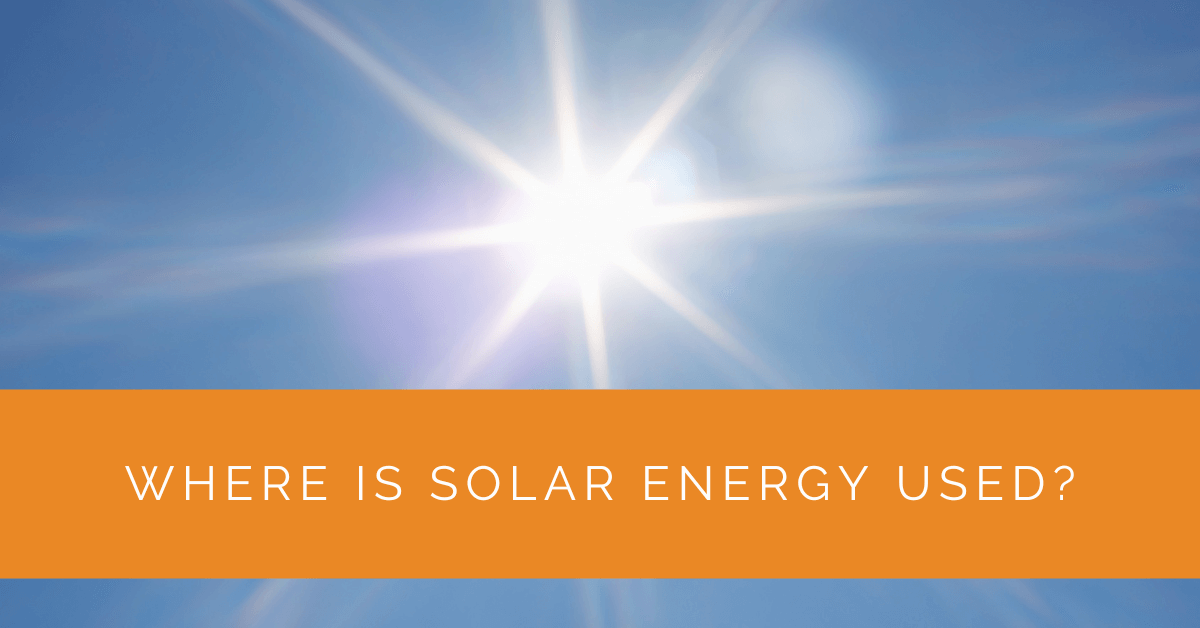Solar energy is an abundant and renewable energy source increasingly being harnessed worldwide. Solar energy is utilized in various applications, from residential homes to large-scale power plants. This article will explore the different areas where solar energy is used and how it contributes to a sustainable future.
Contents
- 1 Key Takeaways
- 2 Solar Energy Resources Around the World
- 3 Solar Energy in Power Generation
- 4 Solar Energy in Residential Applications
- 5 Solar Energy in Commercial and Industrial Applications
- 6 Solar Energy in Transportation
- 7 Solar Energy in Heating and Cooling
- 8 Solar Energy in Remote Areas and Off-Grid Systems
- 9 Solar Energy in Agriculture
- 10 Expert Insights From Our Solar Panel Installers About Common Solar Energy Uses
- 11 Experience Solar Excellence with Us!
- 12 Conclusion
Key Takeaways
- Solar energy is a versatile and sustainable source in various sectors, including power generation, residential and commercial applications, transportation, heating and cooling, remote areas, and agriculture.
- Solar energy offers numerous benefits, including reduced reliance on fossil fuels, cost savings, environmental sustainability, and increased energy independence.
- The widespread adoption of solar energy drives the transition towards a cleaner and more sustainable future, providing opportunities for individuals, businesses, and communities to contribute to a greener planet.
Solar Energy Resources Around the World
Solar energy resources vary globally, with some regions receiving more sunlight than others. Understanding the solar potential of different areas is crucial for effectively utilizing solar energy. Here are some key points to consider:
- Solar Radiation and Insolation: The amount of solar radiation and insolation (sunlight) received in an area determines its solar energy potential. Regions closer to the equator generally receive higher solar radiation, making them ideal for solar energy generation.
- Solar Energy Maps and Data: Various organizations and agencies provide solar energy maps and data indicating different regions’ solar potential. These resources help identify areas with abundant sunlight and guide decision-making for solar installations.
- Regional Variations: Solar energy potential can vary even within a country or region due to latitude, altitude, climate, and local weather patterns. It’s essential to assess these variations to determine the feasibility and efficiency of solar energy projects.
Solar Energy in Power Generation
Solar energy plays a significant role in power generation, providing a clean and sustainable alternative to conventional sources. The two primary methods of solar power generation are photovoltaic (PV) systems and concentrated solar power (CSP) plants. Let’s explore each in detail:
Photovoltaic (PV) Systems
- Solar Photovoltaic Technology: PV systems use solar panels or photovoltaic cells to convert sunlight directly into electricity. Usually made of silicon, these cells create an electric field when exposed to sunlight, generating DC electricity.
- Residential and Commercial PV Systems: PV systems can be installed on rooftops of residential and commercial buildings, harnessing solar energy to power appliances and lighting. They can also be interconnected with the grid, allowing excess energy to be fed back for credit or sold.
- Utility-Scale PV Systems: Large-scale PV systems, often implemented in solar farms or parks, generate significant electricity to supply power to the grid. These systems consist of numerous solar panels connected in arrays, providing megawatts of solar power.
Concentrated Solar Power (CSP) Plants
- Concentrated Solar Power Technology: CSP plants use mirrors or lenses to concentrate sunlight onto receivers containing heat transfer fluids. The concentrated sunlight heats the fluid, generating high-temperature thermal energy.
- Power Generation Mechanism: The thermal energy is then used to produce steam, which drives turbines connected to generators, producing electricity. CSP plants often incorporate thermal energy storage systems, allowing power generation even when sunlight is unavailable.
- Large-Scale Power Generation: CSP plants are suitable for utility-scale power generation, particularly in regions with abundant direct sunlight. They contribute to renewable energy portfolios and grid stability.

Solar Energy in Residential Applications
Solar energy offers numerous benefits to residential settings, allowing homeowners to generate electricity and reduce their environmental impact. Here are key aspects of solar energy usage in residential applications:
Rooftop Solar Installations
- Solar Panel Installation: Residential solar installations typically involve placing solar panels on rooftops to capture sunlight. These panels consist of multiple photovoltaic cells that convert sunlight into electricity.
- Net Metering: Residential solar systems are often connected to the electrical grid, allowing homeowners to benefit from net metering. Excess solar energy generated during the day is fed back into the grid, earning credits that can be used when electricity consumption exceeds solar production.
- Energy Independence and Cost Savings: Installing solar panels allows homeowners to generate electricity, reducing their reliance on the grid and lowering energy bills. Over time, the financial benefits of solar energy can offset the initial installation costs, resulting in significant long-term savings.
- Environmental Impact: Solar energy reduces reliance on fossil fuels, resulting in lower greenhouse gas emissions and a smaller carbon footprint. Residential solar installations contribute to a cleaner and more sustainable environment.
Solar Financing Options
- Solar Loans: Homeowners can obtain solar loans to finance the upfront costs of solar installations. These loans provide the necessary funds to purchase and install solar panels, which can be paid back over time.
- Solar Leases and Power Purchase Agreements (PPAs): Solar leasing and PPAs allow homeowners to “lease” solar panels from solar companies. In exchange for monthly payments or purchasing the electricity generated by the panels, homeowners can benefit from solar energy without upfront costs.
- Government Incentives: Many governments provide incentives, such as tax credits or rebates, to promote the adoption of solar energy. These incentives can offset the costs of solar installations and make them more affordable for homeowners.
Solar Energy in Commercial and Industrial Applications
Commercial and industrial sectors are increasingly embracing solar energy for its economic and environmental benefits. Here are key aspects of solar energy usage in commercial and industrial applications:
Commercial Solar Installations
- Rooftop Solar Systems: Commercial buildings, including offices, warehouses, and retail spaces, can install solar panels on rooftops. These systems generate electricity to meet a portion of the building’s energy needs.
- Solar Carports: Solar carports incorporate solar panels into structures that shade parked vehicles. These installations not only generate electricity but also provide covered parking spaces.
- Financial Savings and Sustainability: Commercial solar installations can result in significant financial savings by reducing energy bills and operating costs. Moreover, adopting solar energy demonstrates a commitment to sustainability, improving brand reputation, and attracting environmentally conscious customers.
Industrial Solar Installations
- Utility-Scale Solar Power Plants: Large industrial facilities and manufacturing plants can invest in utility-scale solar power plants. These plants consist of vast arrays of solar panels and contribute significant renewable energy to the grid.
- On-Site Solar Power Generation: Industries with ample space can install solar panels on-site to generate electricity for their operations. By relying on solar energy, they can reduce reliance on the grid, stabilize energy costs, and demonstrate environmental responsibility.

Solar Energy in Transportation
Solar energy has transformative potential in transportation, offering sustainable alternatives to traditional fossil fuel-powered vehicles. Here are key aspects of solar energy usage in transportation:
Solar-Powered Vehicles
- Solar Electric Vehicles (EVs): Solar panels integrated into EVs can charge the vehicle’s battery using sunlight. These panels provide additional charging options and extend the vehicle’s range, reducing the reliance on external charging stations.
- Solar Charging Stations: Solar energy charging stations use solar panels to generate electricity for charging EVs. These stations can be installed in public spaces, parking lots, or along highways, providing clean and renewable energy for EV owners.
Solar-Powered Public Transportation
- Solar Buses and Trains: Solar energy powers electric buses and trains, reducing emissions and promoting sustainable public transportation. Solar panels on the vehicles capture sunlight and charge the onboard battery, contributing to zero-emission transportation.
Solar-Powered Boats and Aircraft
- Solar Boats: Solar energy can power boats and watercraft, allowing emission-free travel on water bodies. Solar panels capture sunlight and charge the boat’s batteries, enabling clean and sustainable navigation.
- Solar-Powered Aircraft: Solar energy is also utilized to develop solar-powered aircraft. These aircraft incorporate solar panels on their wings, harnessing sunlight to generate electricity and power their onboard systems. Solar-powered aircraft demonstrate the potential for sustainable aviation and contribute to reducing the carbon footprint of air travel.
Solar Energy in Heating and Cooling
Solar energy offers efficient solutions for meeting heating and cooling needs in residential, commercial, and industrial settings. Here are key aspects of solar energy usage in heating and cooling:
Solar Water Heating Systems
- Solar Water Heaters: Solar water heating systems utilize solar energy to heat water for various purposes, such as domestic hot water, swimming pools, and commercial applications. These systems typically consist of solar collectors, storage tanks, and circulating pumps.
- Types of Solar Water Heaters: There are two primary types of solar water heating systems: active and passive. Active systems use pumps to circulate water or heat transfer fluid, while passive systems rely on natural convection to circulate water.
- Advantages of Solar Water Heaters: Solar water heaters offer several benefits, including reduced energy costs, lower reliance on conventional water heating methods, and a smaller carbon footprint.
Solar Space Heating and Cooling
- Solar Air Heating Systems: Solar air heating systems use solar collectors to capture solar radiation and heat air, which is then circulated through buildings for space heating purposes. These systems can be used in residential, commercial, and industrial settings to supplement or replace traditional heating methods.
- Solar Cooling Systems: Solar cooling systems utilize solar thermal energy to drive absorption or desiccant cooling processes, providing building cooling. These systems can be integrated with solar water heating or directly driven by solar thermal collectors.
Concentrated Solar Power (CSP) for Thermal Applications
- Concentrated Solar Power for Thermal Energy: In addition to power generation, concentrated solar power (CSP) technology can be used for thermal applications. CSP systems can generate high-temperature heat, which can be used for industrial processes, including steam production, water desalination, and chemical processing.
Solar energy for heating and cooling purposes offers a sustainable and cost-effective alternative to traditional methods. By utilizing solar energy, individuals, businesses, and industries can reduce their reliance on fossil fuels, lower energy costs, and contribute to a greener and more sustainable future.

Solar Energy in Remote Areas and Off-Grid Systems
Solar energy is vital in providing electricity to remote areas and off-grid communities where access to the electrical grid is limited or non-existent. Here are key aspects of solar energy usage in remote areas and off-grid systems:
Off-Grid Solar Systems
- Stand-Alone Solar Systems: Off-grid solar systems, also known as stand-alone systems, consist of solar panels, batteries for energy storage, and charge controllers. These systems allow users to generate and store electricity, providing power in remote areas without grid connectivity.
- Benefits of Off-Grid Solar Systems: Off-grid solar systems provide reliable and clean energy solutions, enabling access to electricity in areas far from utility power lines. These systems are crucial for powering homes, schools, healthcare facilities, and other essential services.
Solar-Powered Microgrids
- Solar Microgrids: Solar-powered microgrids combine solar energy generation with energy storage and distribution systems to provide electricity to communities in remote areas. These microgrids are often designed with a mix of solar panels, batteries, and backup generators to ensure an uninterrupted power supply.
- Community Empowerment: Solar-powered microgrids empower communities by providing reliable electricity for lighting, communication, education, and healthcare. They offer an opportunity for economic development and improved quality of life in remote areas.
Portable Solar Solutions
- Portable Solar Panels and Devices: Portable solar panels and devices allow individuals to harness solar energy for various purposes. These lightweight and compact solar panels can charge electronic devices, power camping equipment, and provide lighting in remote locations.
- Convenience and Sustainability: Portable solar solutions offer convenience and environmental benefits, allowing users to access clean energy wherever they are. They are particularly useful for outdoor activities, emergencies, or areas with limited infrastructure.
Solar Energy in Agriculture
Solar energy has significant implications for the agricultural sector, offering sustainable solutions and contributing to the overall efficiency of farming operations. Here are key aspects of solar energy usage in agriculture:
Solar-Powered Irrigation Systems
- Solar Water Pumps: Solar-powered water pumps utilize solar energy to provide a reliable and sustainable water supply for irrigation purposes. These systems eliminate the need for grid electricity or fuel-powered pumps, reducing operational costs and environmental impact.
- Efficiency and Water Conservation: Solar-powered irrigation systems offer increased efficiency in water usage, allowing farmers to water their crops precisely when needed. This improves water conservation, reduces waste, and promotes sustainable agricultural practices.
Solar Energy for Livestock and Farm Operations
- Solar-Powered Livestock Waterers: Solar energy is used to power water pumping systems, ensuring a continuous supply of clean water for livestock. These solar-powered waterers are efficient, cost-effective, and environmentally friendly, promoting animal welfare and reducing labor.
- Solar-Powered Equipment: Solar energy can power electric fences, lighting systems, and other equipment essential for agricultural operations. By harnessing solar energy, farmers can reduce their reliance on grid electricity or diesel generators, saving costs and minimizing their carbon footprint.
Solar Energy for Crop Drying and Food Preservation
- Solar Crop Drying: Solar energy can be harnessed for crop drying, a crucial step in food preservation. Solar dryers use the sun’s heat to remove moisture from agricultural products, reducing the risk of spoilage and preserving the nutritional value of crops.
- Solar-Powered Food Preservation: Solar energy can also be used for food preservation techniques such as solar dehydration, canning, and refrigeration. These methods extend the shelf life of food without relying on grid electricity or fossil fuels, contributing to sustainable food systems.
Solar Energy for Greenhouses and Controlled Environment Agriculture
- Solar-Powered Greenhouses: Solar energy can be utilized in greenhouse operations to provide supplemental lighting, heating, and ventilation. Solar panels installed on greenhouse structures can generate electricity to power lighting systems or heat transfer fluids for temperature regulation.
- Controlled Environment Agriculture (CEA): CEA refers to indoor agricultural practices where temperature, light, humidity, and other parameters are carefully controlled. Solar energy can significantly power CEA facilities, providing sustainable energy for indoor farming operations.
Solar energy applications in agriculture contribute to sustainable farming practices, resource efficiency, and reduced environmental impact. By integrating solar solutions into agricultural operations, farmers can optimize their energy usage, reduce costs, and contribute to a greener and more sustainable agricultural sector.
Expert Insights From Our Solar Panel Installers About Common Solar Energy Uses
Solar energy’s versatility is one of its greatest strengths. From residential rooftops to large-scale power plants, the potential applications are virtually limitless.
Senior Solar Energy Consultant
Integrating solar power into transportation is a game-changer. Solar-powered EVs and charging stations are pushing us towards a greener and more sustainable future.
Transportation Solar Energy Expert
In agriculture, solar energy not only powers irrigation systems but also supports sustainable farming practices. It’s an essential tool for modern, eco-friendly agriculture.
Agricultural Solar Solutions Specialist
Experience Solar Excellence with Us!
Trust in Solar Panels Network USA, where our seasoned experts deliver top-quality solar solutions for homes and businesses nationwide. With a legacy of countless successful installations and a commitment to sustainable energy, we’re your reliable partner in the solar journey. Ready for a brighter, eco-friendly future? Call us now at (855) 427-0058 and harness the power of the sun!
Conclusion
Solar energy is a versatile and renewable energy source used in various applications worldwide. From residential homes to large-scale power plants, solar energy contributes to a sustainable and greener future. We harness the sun’s power to generate clean electricity, reduce greenhouse gas emissions, and promote energy independence. As solar energy technologies continue to advance, solar power will only increase, paving the way for a more sustainable and environmentally conscious world.
About the Author
Solar Panels Network USA stands at the forefront of solar energy solutions, driven by a team of seasoned solar engineers and energy consultants. With over decades of experience in delivering high-quality solar installations and maintenance, we are committed to promoting sustainable energy through customer-centric, tailored solutions. Our articles reflect this commitment, crafted collaboratively by experts to provide accurate, up-to-date insights into solar technology, ensuring our readers are well-informed and empowered in their solar energy decisions.

